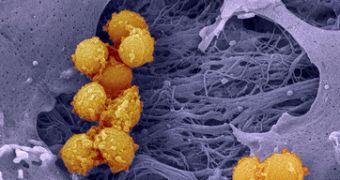A team of chemists from Yale University has engineered the cell wall of the very dangerous Staphylococcus aureus bacteria, by tricking it into integrating foreign small molecules and fixing them into the cell wall.
The scientists led by Yale chemist and study leader David Spiegel, introduced into one end of the small molecules a certain peptide sequence that the bacteria would recognize.
In the case of Staphylococcus aureus, the enzyme that attaches proteins to the cell wall is called sortase A and what the scientists did was to fool the bacteria to attach something that it had not produce, Spiegel explained.
“It's as if the cell thought the molecules were its own proteins rather than recognizing them as something foreign.”
The reason for which the researchers focused on the cell wall was because the cell itself uses a lot of wall components to relate to its environment, so by “by being able to manipulate the cell wall, we can in theory perturb the bacteria's ability to interact with human tissues and host cells,” added Spiegel.
For the experiment, they used 3 different small molecules – biotin, fluorescein and azide, but the technique can include other molecules and work on other types of bacteria too.
And as this technique does not need a prior genetic altering of the bacteria, it can be used on naturally occurring bacteria in the human body.
This discovery is pretty big as Staphylococcus aureus infections and mainly drug-resistant MRSA are worse than plague.
Lately, more Americans die every year from Staphylococcus aureus infections alone, than from other serious diseases like HIV/AIDS, emphysema or Parkinson's disease.
Engineering the cell walls of bacteria means that many illnesses will be treatable and it will be easier for scientists to study diseases.
“For example, if we tag these bacteria with small fluorescent tracer molecules, we could watch the progression of disease in the human body in real time.”
The small molecules could also serve as a boost to the body's immune system against disease that do not manifest right away like HIV/AIDS or cancer, for example.
Spiegel added that “this technique has the potential to help illuminate basic biological processes as well as lead to novel therapeutics from some of the most common and deadly diseases affecting us today.”
This is the first time that scientists have engineered the cell wall of organisms responsible for Staph infections, pneumonia, strep throat and many others.
The results have been described online in the journal ACS Chemical Biology this week.

 14 DAY TRIAL //
14 DAY TRIAL //